A modernized eight treasure rice that tastes so much better than the traditional version. Lightly sweetened sticky rice stuffed with red bean paste and topped with dried fruits and seeds, then served with a fragrant chrysanthemum syrup that has an amazing earthy aroma. The recipe uses ingredients that are easy to source and the cooking is quite simple. It’s a light and healthy dessert that is perfect to serve at the end of a meal. {Vegan, Gluten-Free}
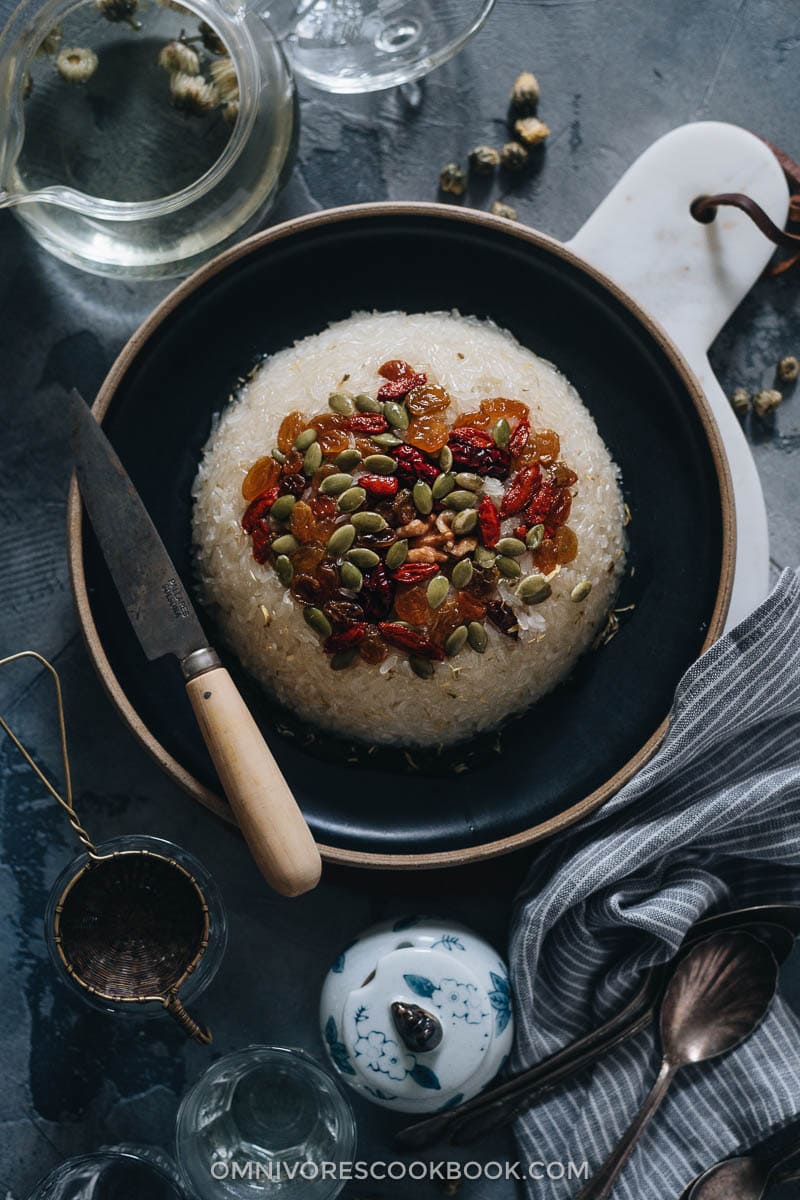
Sometimes food tastes better when it’s slightly upgraded from the traditional version, such as the Chinese Almond Cookies. This eight treasure rice is another good example.
If you’ve never heard of eight treasure rice, it’s a dessert made from sweetened sticky rice. It’s quite similar to Mango Sticky Rice, but topped with dried fruits and seeds. Traditionally, the dish uses eight different toppings, A.K.A. eight treasures. It a dish commonly served during Chinese New Year and other Chinese festivals.
I was never into eight treasure rice until I tasted the dish at Birds of a Feather, one of my favorite Chinese restaurants in Brooklyn. Unlike the traditional eight treasure rice, their version uses fewer toppings to create a more balanced texture and taste. They also use Osmanthus Syrup to give it a floral and herbal aroma that makes the sticky rice shine. I was so impressed with their eight treasure rice so I decided to make a version similar to it.
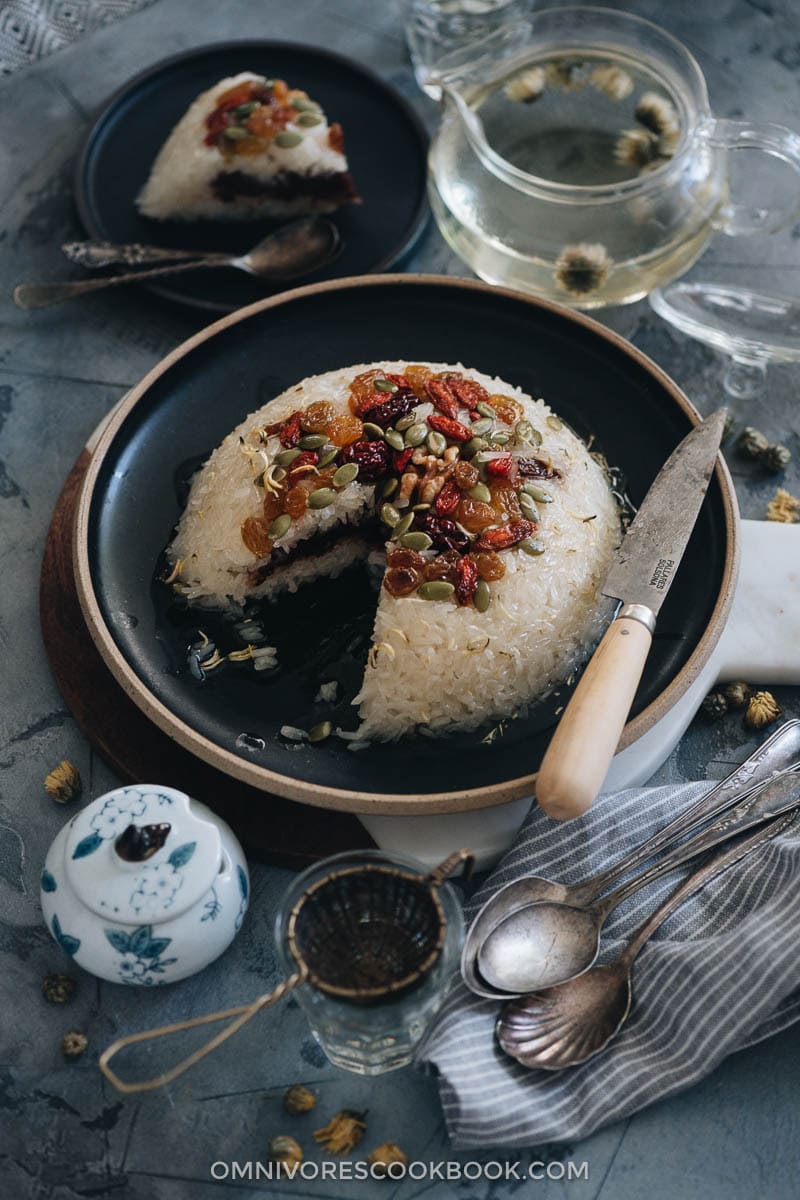
Why this recipe
Traditionally, eight treasure rice includes a TON of toppings. For example, things like candied lotus seeds, dried mangoes, dried apricots, dried prunes, ginkgo nuts, chestnuts, peanuts, canned oranges, and pickled cherries. Let’s face it, the combination of all these ingredients doesn’t taste that good. They are common ingredients in China and I always think people put them together more as a symbol of abundance than one of taste.
That’s why I modernized the traditional version by:
- Using fewer toppings to create a better taste. The toppings I used are also easier to find. I’ve also included notes on how to use alternative ingredients.
- Using coconut oil to replace lard (yep, traditional recipes use lard!) to further add fragrance. I also tried regular oil and butter. Neither of those worked.
- Using homemade chrysanthemum syrup to add an earthy aroma.
- Making the recipe flexible enough to create a single-serving sized dessert.
The result is a beautiful (and healthy) dessert that you actually want to eat or serve at your Chinese New Year party.
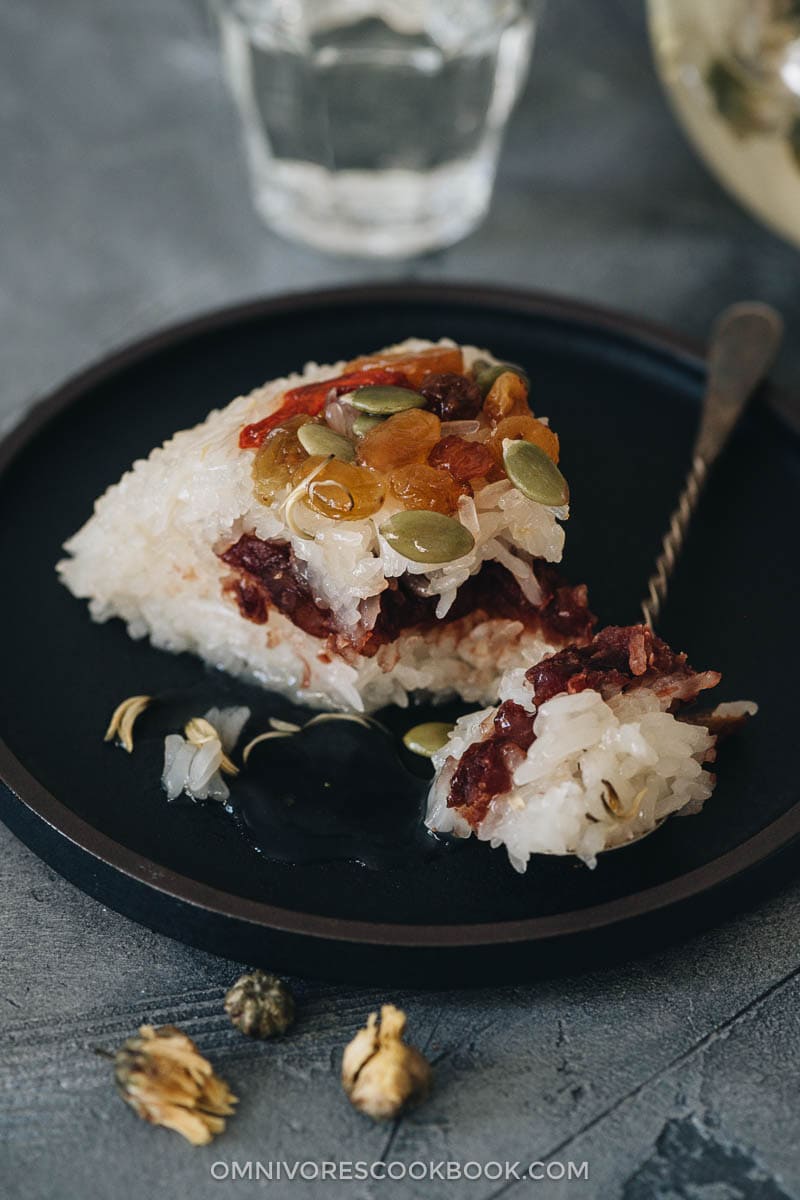
Topping options
The eight treasure rice I ate at Birds of a Feather only had three toppings – dried jujubes, pumpkin seeds, and golden raisins. The combination tasted great.
I added two more ingredients – walnuts and goji berries. I do like the nice zing and health benefits of goji berries. The walnuts are more for appearance (although they ended up half-buried in the rice).
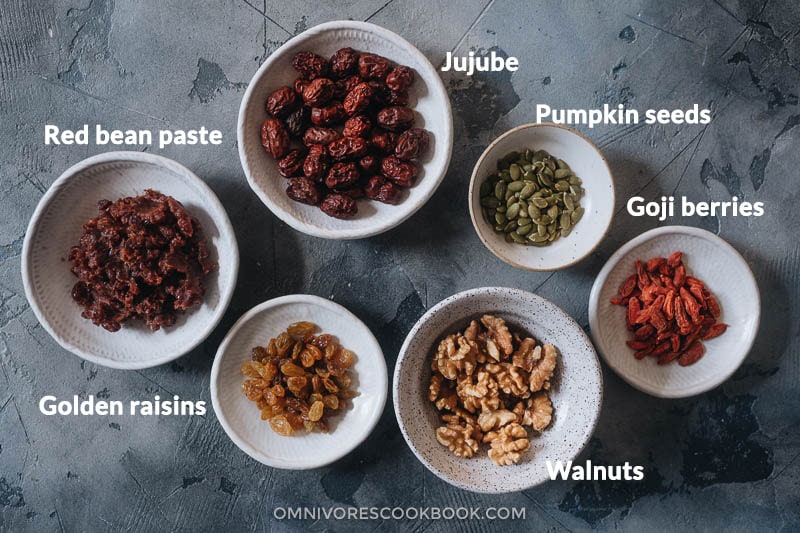
If you want to customize the toppings, I highly recommend you use only 3 to 5 ingredients to create a cleaner taste. You can use a combination of dried fruits, nuts, and seeds, adding whichever ones you have on hand.
Some of my other favorite toppings include: dried lotus seeds (you need to soak them overnight before using them), pine nuts, sunflower seeds, dried mango, cranberries, and cooked chestnuts.
Chrysanthemum syrup
Birds of a Feather’s eight treasure rice uses Osmanthus Syrup to add an earthy aroma. You can purchase it at a Chinese market. However, it’s a special ingredient that I could not find on Amazon. Plus, not all Chinese markets carry it. That’s why I decided to develop my own syrup recipe to replace it.
I chose to use chrysanthemum buds to make the syrup, because they have a similar taste to osmanthus and the buds are easier to find. You can get them at most Asian markets, at tea shops, or on Amazon. Plus you can use the leftovers to make a very delicious tea.
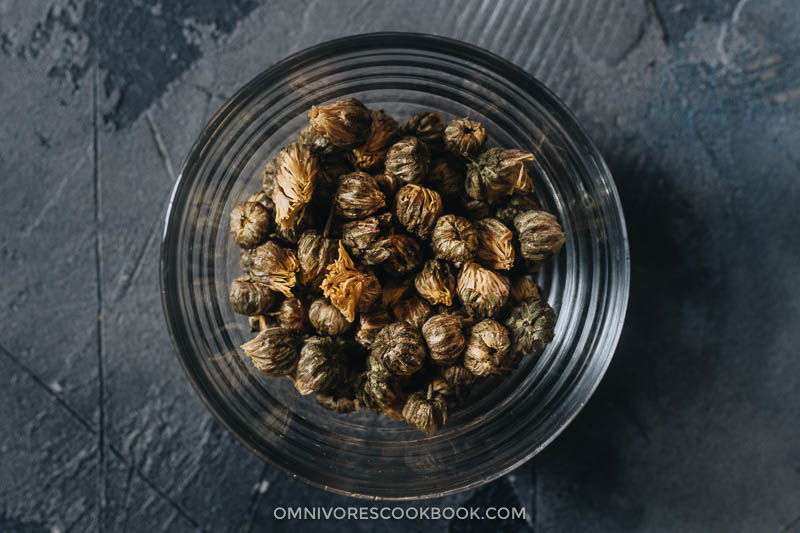
Making chrysanthemum syrup is easy. Just:
- Boil the flower buds with water and some sugar.
- Let it simmer to brew a strong tea
- Add a cornstarch slurry to thicken it
- Drain and remove the buds
I used a small amount of sugar to create a less sweet syrup, so the chrysanthemum tea flavor would come through. The flavor works perfectly with the dessert.
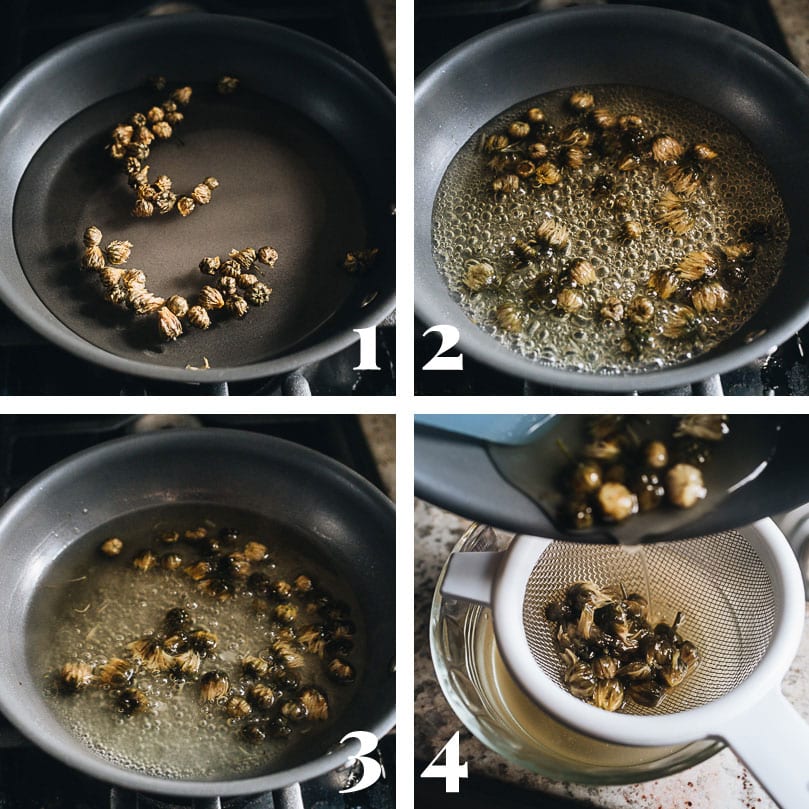
How to make eight treasure rice
Soak the glutinous rice
You have to soak the glutinous rice before cooking it. Ideally, you should soak it overnight. But if you’re short on time, 3 hours of soaking will be enough. In this case, you’ll need to cook the rice longer.
Cooking process
- Steam the glutinous rice (first steam)
- Mix the rice with coconut oil and sugar
- Spread the toppings on the bottom of the bowl
- Add a layer of cooked glutinous rice
- Add the red bean paste layer
- Fill up the bowl with the rest of the rice
- Steam the second time, then drizzle with the syrup
- Plate the rice and serve

What type of bowl to use
You’ll need to use a heat-proof bowl. For example, a ceramic bowl will work perfectly.
As for the shape, a shallow bowl with a big surface area is perfect, so you can spread on more toppings that pair with the rice.
The bowl I used can hold 2 1/2 cups of water. It’s about 6.5” (16 cm) in diameter and 2” (5 cm) tall. It fits perfectly for this recipe. You can use a bowl of similar size. Or you can use smaller bowls to make serving-sized desserts. The assembly method is the same.
One word on the red bean paste
Some eight treasure rice recipes do not use red bean paste. I think the paste adds a great taste so I always prefer to use it. Homemade red bean paste is the perfect option, because you can control the sweetness and the texture of the paste. If using store-bought, try to find a high-quality red bean paste, preferably a Japanese brand. This is the brand I used. I like it because it has some bean texture and is not completely smooth. Avoid cheap-looking red bean pastes. They taste really bad and will ruin the dish.
Afterthoughts
Chinese cuisine is not well-known for its desserts, but there are some great dishes here and there. If you’re looking for something to serve at the end of your Chinese dinner party or a healthy sweet dish to satisfy your midnight hunger, I would highly recommend this recipe. It might look a bit long, but it’s actually surprisingly easy to make. And you can make it in advance because it reheats well.
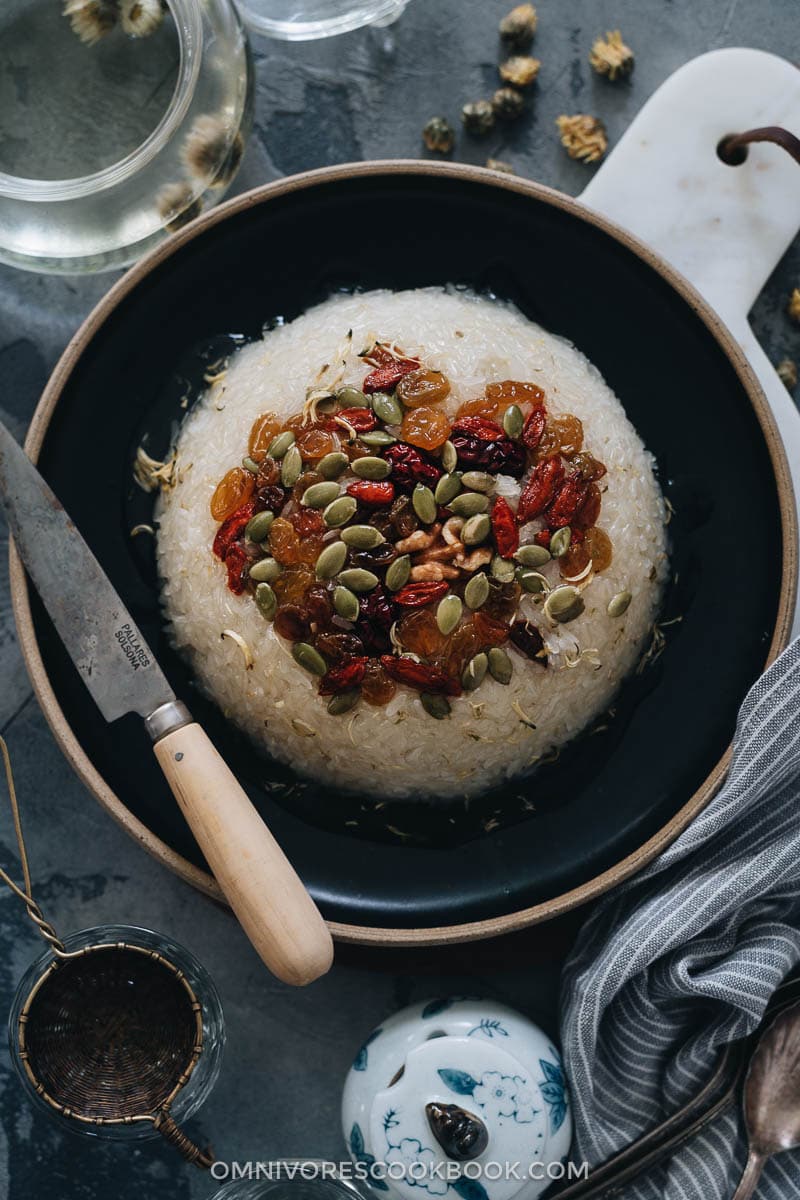
More delicious Chinese dessert recipes
- Chinese Almond Cookies
- Soft Cinnamon Rolls with Sesame
- Sesame Checkerboard Cookies
- Red Bean Soup
- Chinese Banana Fritters
If you give this recipe a try, let us know! Leave a comment, rate it (once you’ve tried it), and take a picture and tag it @omnivorescookbook on Instagram! I’d love to see what you come up with.
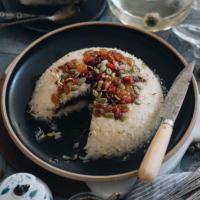
Eight Treasure Rice (八宝饭, Chinese Rice Pudding)
Ingredients
Rice
- 1 1/2 cups (360 ml) glutinous rice
- 2 tablespoons coconut oil (or shortening)
- 1 tablespoon sugar
- 4 tablespoons red bean paste (Homemade or Store-bought)
Toppings (*Footnote 1)
- 3 jujubes
- 1 tablespoon golden raisins
- 1 tablespoon pumpkin seeds
- 1/2 tablespoon goji berries
- 1 walnut half
Syrup (or use store-bought Osmanthus Syrup)
- 1 cup water
- 2 tablespoons sugar
- 1 heaping tablespoon dried chrysanthemum buds
- 1 teaspoon cornstarch
Instructions
Soak rice ahead
- Cover the glutinous rice with 2” (5cm) cold water and soak it for a minimum of 3 hours, preferably overnight.
1st steam
- Once soaked, drain off the water and rinse the rice a few times.
- Prepare your steamer by bringing the water to a boil.
- Add the soaked rice into a heat-proof bowl and place it on the steamer rack. Steam, covered, for 30 minutes for overnight-soaked rice, or for 45 minutes for 3-hour-soaked rice. Once done, the rice should be edible, but still quite tough.
Assemble
- While steaming the rice, arrange the rice toppings in the base of a wide heat-proof bowl. (*Footnote 2)
- Once the rice is steamed, add the coconut oil and sugar. Stir thoroughly until the sugar melts and the rice is evenly coated with oil.
- Press the seasoned rice into the bowl with the toppings. Be careful not to disturb the pattern you’ve created. Fill two thirds of the bowl with rice while creating a dent in the middle for the red bean paste.
- Add the red bean paste in the middle and use the back of a spoon to flatten it into a thin layer.
- Add the rest of the rice and use a spoon to flatten it.
- At this stage, you can store the rice, covered with plastic wrap, in the fridge for 1 to 2 days. Follow the rest of the instructions prior to serving.
2nd steam
- Place the assembled rice back to the steamer and steam it for an additional 30 minutes.
Syrup
- Prepare the syrup while steaming the assembled rice. Combine the water, sugar, and chrysanthemum buds in a small saucepan and heat it over medium heat until boiling. Turn to medium-low heat. Simmer for 10 minutes.
- Mix the cornstarch with 1 teaspoon of water until the cornstarch has dissolved completely.
- When the chrysanthemum mixture is cooked, pour in the cornstarch slurry. Keep cooking and stirring constantly, until the syrup slightly thickens. Pour the syrup over a strainer into a bowl and discard the chrysanthemum buds.
Serving
- When the treasure rice is done steaming, drizzle a few spoons of syrup onto the rice. Let it sit for 10 minutes.
- To plate the rice, put a plate over the bowl and flip it in one swift motion. Remove the bowl and pour the remaining syrup over top of it. Serve warm.
Store
- The cooked treasure rice can be stored in an airtight container in the fridge for up to 2 days. You can reheat it in the microwave.
Notes
- The toppings of the eight treasure rice are super flexible. I prefer to use fewer toppings, which produces a tastier result. Ideally, you should use some berries, nuts, and/or seeds to create a varied texture. See my blog post above for other topping options.
- The bowl I used can hold 2 1/2 cups of water. It’s about 6.5” (16 cm) in diameter and 2” (5 cm) deep. It fits perfectly for this recipe. You can use a bowl of similar size. Or you can even use smaller bowls to make serving-sized portions.
Nutrition
Lilja Walter is a part of the Omnivore’s Cookbook team and worked closely with Maggie to develop and test this recipe.
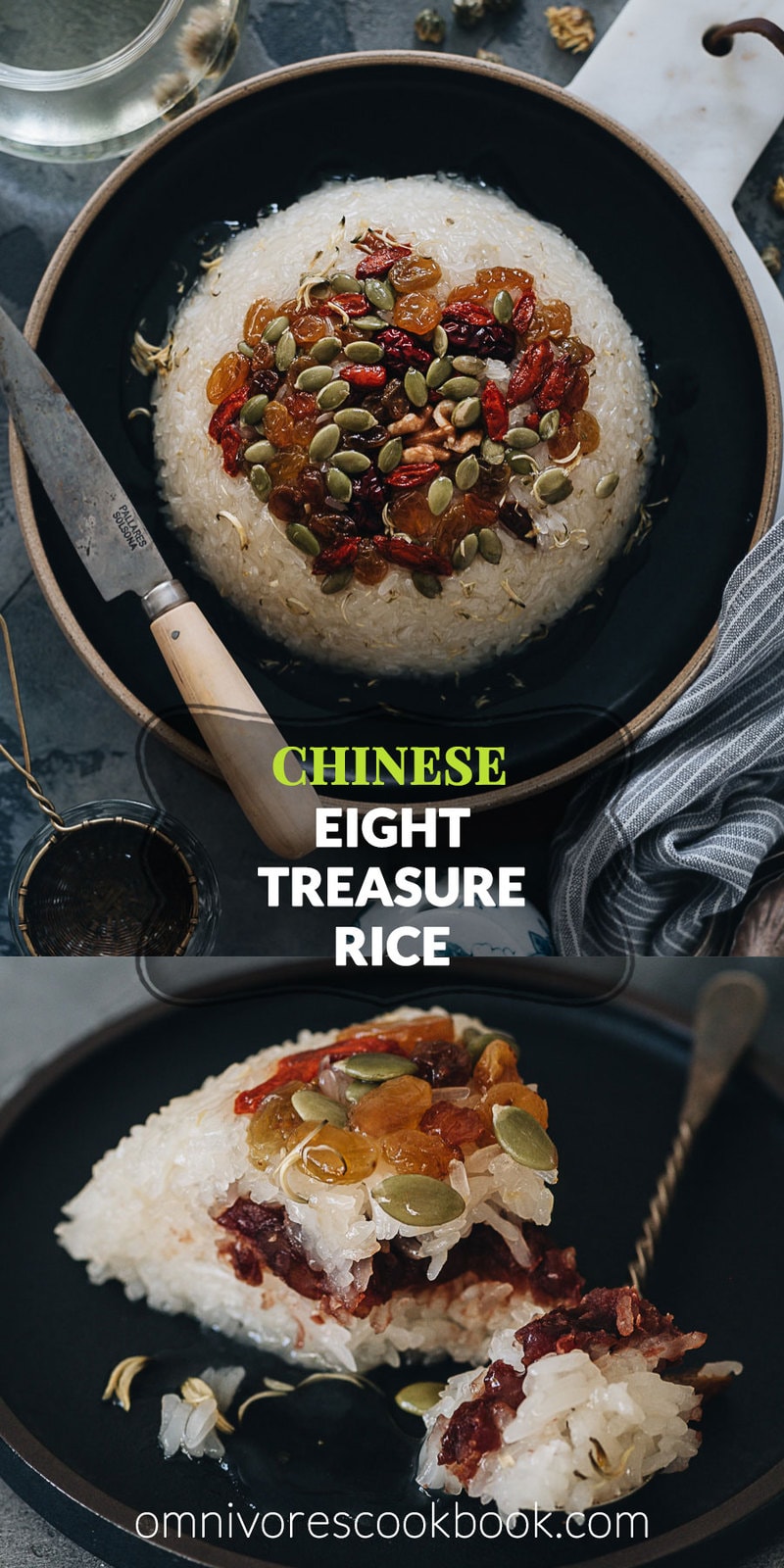













This is fantastic and so pretty! I used the Nishiki rice and made one yesterday. I will be making this for Chinese New Year also. I can’t get the chrysanthemum buds so I made a syrup with ginger and cardamom. I also made the red bean paste from your recipe!
I am thoroughly enjoying your site Maggie! I’ve been making Chinese (and Indian) food for many years, and it’s delightful to find so many new recipes to try! I’ve already made many things from here! Your instructions are clear, and the recipes are interesting, authentic and delicious!
Happy New Year!
Do we have to let it sit before doing the second steam?
Hi Joyce, you don’t need to let the rice sit before the second steam.
Hi, thanks for the recipe! Do you think we can make this one day in advance? may be reheat it before serving?
You totally can! Just make sure not to add the syrup and store it separately.
You can heat it up by steaming before serving. (Don’t need to serve it hot, I really like it warm or just above room temperature)
Hi Maggie, do you think I could sub in non glutinous brown rice for this recipe? My parents love this but due to medical reasons, they can’t eat that much sugar.
P.S. love your recipes! Thanks for sharing them 🙂
I don’t think you can directly sub brown rice in this recipe. Brown rice absorb way more water than glutinous rice, so you cannot just soak them and steam them without adding any water. I would use the regular rice cooking method (either in a rice cooker or on stovetop using a pot) and add the correct amount of water with the rest of the seasonings. You can always add the red bean paste and toppings once the rice is cooked. The texture of the dish will be very different if using non-glutinous rice.
Another idea – maybe you can try to use non glutinous black rice. It has a very nice texture and it is so delicious with the red bean paste. Again, you probably need to cook it using rice cooker or stovetop and add in the rest ingredients later.